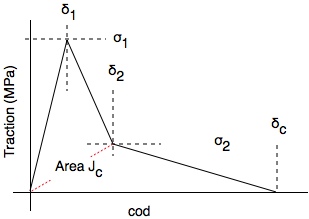Trilinear Traction Law
The Traction Law
This traction law assumes a piece-wise linear relation with two arbitrarily-specifiable break points (i.e., three linear pieces). There are separate traction laws for opening displacement (mode I) and sliding displacement (mode II).
The toughness is
[math]\displaystyle{ J_c = {1\over2}\bigl(\sigma_1\delta_2 + \sigma_2(\delta_c-\delta_1)\bigr) }[/math]
The traction law for each mode depends up seven properties - (δ1,σ1) and (δ2,σ2) breakpoints, critical COD (δc), total area or toughness (Jc), and the initial elastic slope (k). You must enter exactly 5 of these seven properties for each mode. Furthermore, if one of the 5 is the initial slope, then either σ1 or δ1 for that mode (but not both) must be one of the five specified properties. The two remaining unspecified parameters will be calculated from the five provided parameters. The final law must satisfy δ1 ≤ δ2 ≤ δc, δc > 0, σ1 ≥ 0, σ2 ≥ 0, and σ1+σ2 > 0.
One useful interpretation of a trilinear law is that is is modeling two physically mechanics. The total toughness or is the total area under the curve and is give above. The first failure mechanism can be identified with the area under the first peak and bounded by the dotted red line in the above figure. This partial area is the toughness for the first mechanism and is equal to
[math]\displaystyle{ J_1 = {1\over2}(\sigma_1\delta_2 - \sigma_2\delta_1) }[/math]
The remaining area is associated with the second process. It toughness is equal to
[math]\displaystyle{ J_2 = {1\over2}(\sigma_2\delta_c) }[/math]
For example, the first peak might be associated with crack tip fracture toughness while the tail models a process zone such as fiber bridging. In fact, in the limit as σ1 → ∞ and δ2 → 0, a simulation with a pre-existing cohesive zone should approach a simulation propagating a crack tip using fracture mechanics along with a linear softening traction law having σ2 as the cohesive stress. NairnMPM can do both these simulations and the results will be similar. The pure cohesive zone simulations is done by creating using a trilinear traction low on an existing crack. The combined fracture mechanics/cohesive zone simulation starts with a crack that propagate with energy release rate at the crack tip is equal to J1. Furthermore, the crack propagation commands are set to leave a cohesive zone in the wake of the crack. This cohesive zone can be a |triangular traction law with is toughness equal to J2 and stress equal to σ2. Both these types of simulations are described in Nairn (2009).[1]
Failure
Traction Law Properties
The following properties are used to create a triangular traction law:
| Property | Description | Units | Default |
|---|---|---|---|
| (other) | Properties common to all traction laws | varies | varies |
